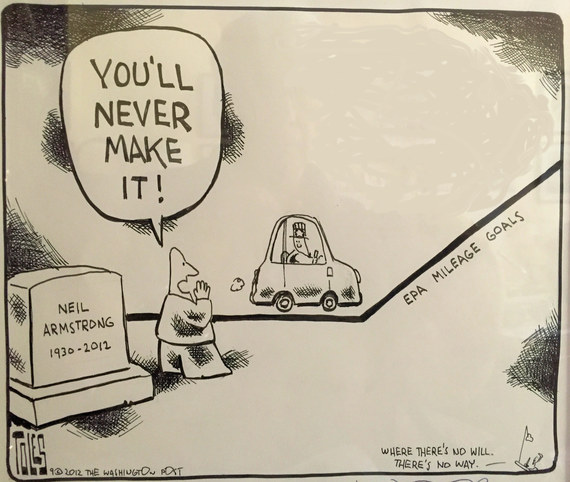This week the US Environmental Protection Agency (EPA), the National Highway Traffic and Safety Administration (NHTSA) and the California Air Resources Board (CARB) released a very positive report regarding the historic federal greenhouse gas and fuel economy standards. In a nutshell, car manufacturers can meet the current 2025 goals to improve efficiency and slash greenhouse gas emissions at a cost similar or less than expected four years ago.
But despite these clear and comprehensive findings, some elements in the auto industry will inevitably push back, arguing that the rules will be too expensive or that gasoline prices are so low that customers don't want fuel-efficient vehicles.
These arguments against long-term standards are myopic. Remember that when these rules were first adopted in 2009, the auto industry was in collapse. The fate of iconic car companies, for decades the pride of the United States, was a huge question mark. Eventually, the federal government decided to throw GM, Chrysler and Ford a multi-billion dollar lifeline. It was in the midst of these economic conditions, with fragile domestic manufacturers and gasoline prices around $2.00 a gallon--actually lower than today--that EPA, NHTSA and CARB first began developing today's greenhouse gas and fuel economy standards.
To its credit, domestic and foreign manufacturers agreed to the groundbreaking standards. American manufacturers realized they had become overly dependent on heavy, gas-guzzling trucks and SUVs. In 2009, they began to chart a new course that would ensure their long-term competitiveness, both domestically and globally. They bet on building a next generation of vehicles for a cleaner and more efficient future. The environmental upside to this innovation was staggering. Six billion metric tons of CO2 emissions would be avoided and consumers would save $1.7 trillion at the pump.
So how does the auto industry stand seven years later? Have manufacturers crashed and burned? No. From a bankrupt shambles in 2009, US auto industry sales have expanded dramatically. In 2015, they grew by 4.5 million vehicles, numbers on par with historic highs. Profits are also back on solid footing. GM, the largest of the Big Three, has swung from a $30.9 billion loss in 2008 to nearly $10 billion in profits in 2015. In fact, according to one analysis, the "Big Three" stand to fully recover compliance costs and be even more profitable per a range of future scenarios.
What about the variety of vehicles available? It's the largest and most diverse ever. The vast majority of vehicles are still internal combustion, but there are more than 76 alternative powertrain models available. Drivers can choose a large Chevy Suburban with a conventional engine, a hybrid Ford Focus or an all-electric Nissan Leaf. And every single model is more efficient than its 2009 counterpart, making it less polluting and cheaper to operate.
Does the industry have problems meeting the standards? Not at all. In fact, according to the EPA, over a quarter of the 2015 models met the 2018 standards. Fuel economy is at the highest level ever by 5 miles per gallon since 2004. Currently, the 2016 Honda Civic and the Scion iA already meet the 2023 standards. Several Ford-150 models already meet the 2021 standards, as do the Toyota Rav4, Chevy Malibu hybrid and Chevy Cruze.
Just seven years after the auto industry's 2009 nadir, it is in the midst of an innovation renaissance. The costs and the performance of current powertrain technologies are advancing faster than was anticipated. New technologies, such as Li-Ion batteries - the primary driver of cost in an electric vehicle - have come down nearly 70% in the last 6-7 years. So, even with national gasoline prices averaging $2.34 a gallon in early June, an electric vehicle is still about 50 percent cheaper to fuel than a gasoline vehicle.
The drop in battery costs is also translating into greater range. The mid-priced Chevy Bolt EV, which boasts a 200-mile range before being recharged, will be available at the end of the year. Tesla's mid-priced all-electric Model 3, expected in 2018, got over 400,000 advance orders in a matter of weeks. After federal incentives, both are expected to cost around $30,000 - cheaper than the average transaction price of a vehicle last December. What's more, that pricing is based on an electric vehicle market that is less than 1% of all car sales. Over the next decade, increased market penetration combined with technology advances will reduce those prices even further.
Meanwhile, what seemed like science fiction just decades ago is quickly becoming reality. A tech company, Google, continues to make rapid advances in self-driving. Cars with fuel cell powertrains produce only water from the exhaust. The first generation fuel cell production car, the Toyota Mirai is already available for sale in California.
The innovation that has been unleashed over the past seven years is exactly what is needed to take on the biggest threat to our future: climate change. But while it is merely a good start, these rules are not nearly enough for the world to avert the worst impacts of climate change. This past December, nations from around the world agreed that we have to keep average global temperatures from rising more than 2º Celsius from 2005 levels by 2050. In order to meet that goal, the International Energy Agency projects that we will need 100 million electric cars on the road by 2030--up from the 1.26 million in 2015. This is a huge task--but it is still doable with companies continuing to invest and the right government policies.
This year, as the regulatory agencies review the 2025 standards, industry voices should not be calling for the standards to be rolled back. This is not the time to again look in the rearview mirror. Instead, industry and government must set ambitious future targets for 2030 and beyond. We need to provide long-term certainty for the innovative companies that have set us on our current trajectory. We must enhance the Nation's energy security. We have to deal head-on with climate change.
To do so, EPA, NHTSA and CARB should consider setting greenhouse gas standards for cars in 2030 that would lead to a significant number of plugged-in electric vehicles to be on the road. Once again, the auto industry should bring its expertise to be an integral part of the process.
Government policies should also consider incorporating electric vehicles that are shared and autonomous into the standards. Shared and autonomous cars have the potential to use much less fuel or electricity. Under the right government policies and incentives, these vehicles could contribute to lower greenhouse gas emissions and other air pollutants, while reducing congestion and accidents.
These type of commitments will help us avoid the worst impacts of climate change. Setting our standards higher is the only way to shift the balance from an intensely polluting fossil fuel economy to a cleaner and more sustainable future. They will also help the nation's automakers be global leaders in environmental innovation and, as already demonstrated, to profitably secure their futures.

